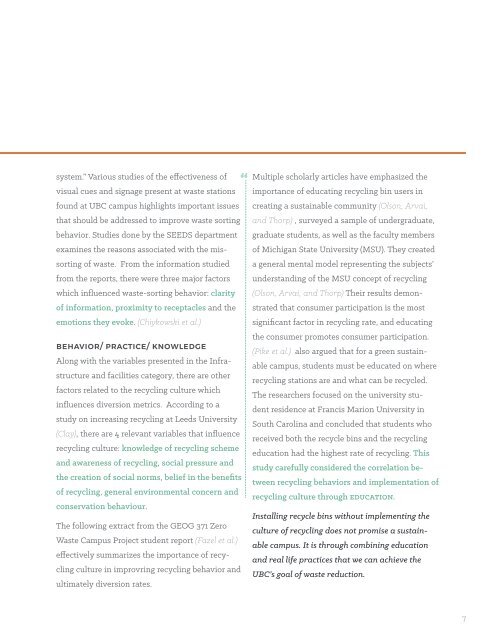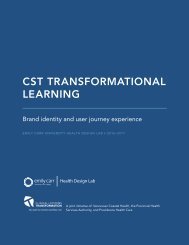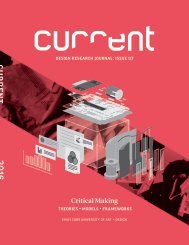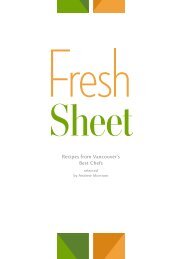Jordan Anthony Process Book
Process book for Melt collective project
Process book for Melt collective project
You also want an ePaper? Increase the reach of your titles
YUMPU automatically turns print PDFs into web optimized ePapers that Google loves.
system.” Various studies of the effectiveness of<br />
visual cues and signage present at waste stations<br />
found at UBC campus highlights important issues<br />
that should be addressed to improve waste sorting<br />
behavior. Studies done by the SEEDS department<br />
examines the reasons associated with the missorting<br />
of waste. From the information studied<br />
from the reports, there were three major factors<br />
which influenced waste-sorting behavior: clarity<br />
of information, proximity to receptacles and the<br />
emotions they evoke. (Chiykowski et al.)<br />
behavior/ practice/ knowledge<br />
Along with the variables presented in the Infrastructure<br />
and facilities category, there are other<br />
factors related to the recycling culture which<br />
influences diversion metrics. According to a<br />
study on increasing recycling at Leeds University<br />
(Clay), there are 4 relevant variables that influence<br />
recycling culture: knowledge of recycling scheme<br />
and awareness of recycling, social pressure and<br />
the creation of social norms, belief in the benefits<br />
of recycling, general environmental concern and<br />
conservation behaviour.<br />
The following extract from the GEOG 371 Zero<br />
Waste Campus Project student report (Fazel et al.)<br />
effectively summarizes the importance of recycling<br />
culture in improvring recycling behavior and<br />
ultimately diversion rates.<br />
Multiple scholarly articles have emphasized the<br />
importance of educating recycling bin users in<br />
creating a sustainable community (Olson, Arvai,<br />
and Thorp) , surveyed a sample of undergraduate,<br />
graduate students, as well as the faculty members<br />
of Michigan State University (MSU). They created<br />
a general mental model representing the subjects’<br />
understanding of the MSU concept of recycling<br />
(Olson, Arvai, and Thorp) Their results demonstrated<br />
that consumer participation is the most<br />
significant factor in recycling rate, and educating<br />
the consumer promotes consumer participation.<br />
(Pike et al.) also argued that for a green sustainable<br />
campus, students must be educated on where<br />
recycling stations are and what can be recycled.<br />
The researchers focused on the university student<br />
residence at Francis Marion University in<br />
South Carolina and concluded that students who<br />
received both the recycle bins and the recycling<br />
education had the highest rate of recycling. This<br />
study carefully considered the correlation between<br />
recycling behaviors and implementation of<br />
recycling culture through education.<br />
Installing recycle bins without implementing the<br />
culture of recycling does not promise a sustainable<br />
campus. It is through combining education<br />
and real life practices that we can achieve the<br />
UBC’s goal of waste reduction.<br />
7

















